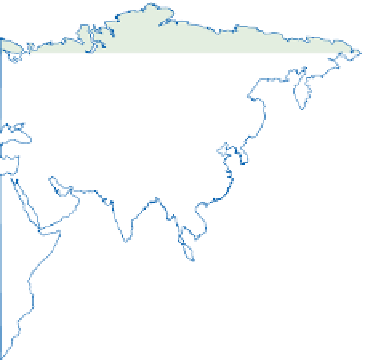Geoscience Reference
In-Depth Information
LONGITUDE
180°
120°
60°
60°
120°
0°
80°
80°
Warm current
Cold current
60°
60°
. )
40°
40°
20°
20°
NORTH EQ UATORIAL
T O
R
0°
0°
SOUTH EQ UATORIAL
EQUATORIAL
COUNTER CURRENT
20°
20°
SOUTH EQUATORIAL
40°
40°
C
T
I
A
60°
60°
C
60°
120°
180°
120°
60°
0°
flows back eastward, between the westward limbs of each
hemispheric gyre, opposed by only slight winds, between
3
Ocean, and although AABW also spills into the Pacific
there is no equivalent northern Pacific cold outflow. As a
result, warmer, less dense
Pacific and Indian Ocean
Common Water
(PICW) completes the circulation
through a sinuous limb into the Atlantic Ocean, rejoining
the Gulf Stream. Subsidence of NADW therefore
contributes directly to a convective and density-driven
system which draws a return surface flow of warm water
into the North Atlantic. Involvement of the vast bulk of
Earth's 1·4 G km
3
of ocean water compensates for the
slowness of thermohaline circulation. Its unimpeded
trans-equatorial flow earns the alternative title
Global
Ocean Conveyor
(
Figure 11.12
).
N and 10
N (the Doldrum belt) at the thermal equator.
Thermohaline (deep) circulation
Surface ocean circulation overrides the vital slower motion
of the deep ocean. The
thermohaline circulation
(THC)
moves at speeds of 10-50 km yr
-1
, driven by water masses
of different densities determined by temperature and
salinity properties. It is isolated from the surface by the
thermocline except at points of formation and has an
average cycling time of 500-2,000 years. Strong radiative
cooling of warm currents, as they approach polar oceans,
complements dense
bottom water
formation in cold,
saline-enriched sea ice environments at two principal
centres. North Atlantic's icy straits pour
North Atlantic
Deep Water
(NADW) southwards as a tongue penetrating
to 60
TIDES AND WAVES
Tides
S, between even denser north-moving
Antarctic
Bottom Water
(AABW) and less dense
Antarctic Interme-
diate Water
(AAIW). AABW is generated beneath the
Antarctic convergence and undercuts NADW to about
40
We turn, finally, to the most familiar part of ocean
movement - tides and waves, which have the greatest
immediate impact at the coastline through their
transmission of
energy
. Tides transfer
mass
from one part
of the global ocean to another in a regular, oscillating
N, where it becomes trapped in deep troughs. The
same 'pincer movement' cannot occur in the Indian




























































































































































































































































































































